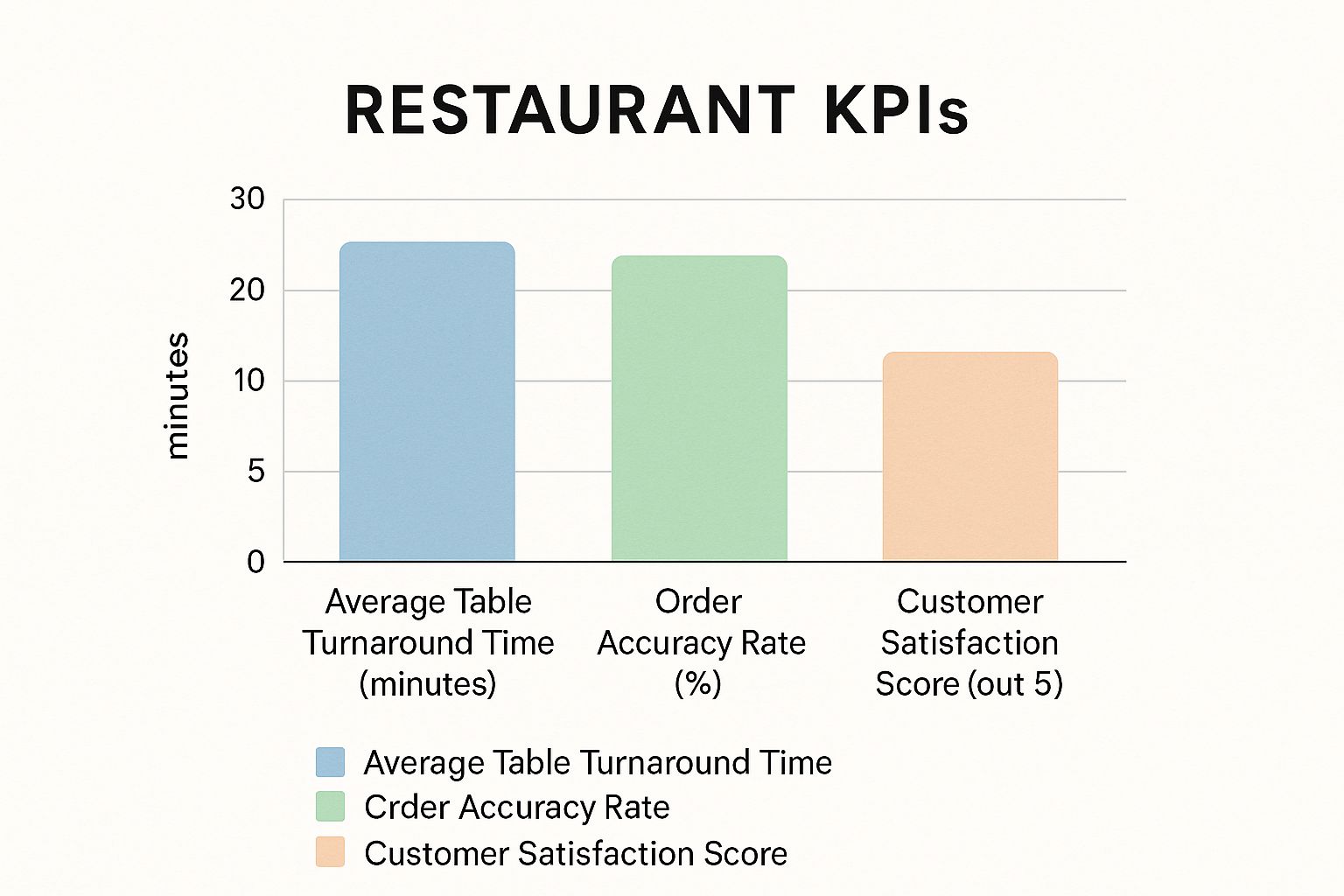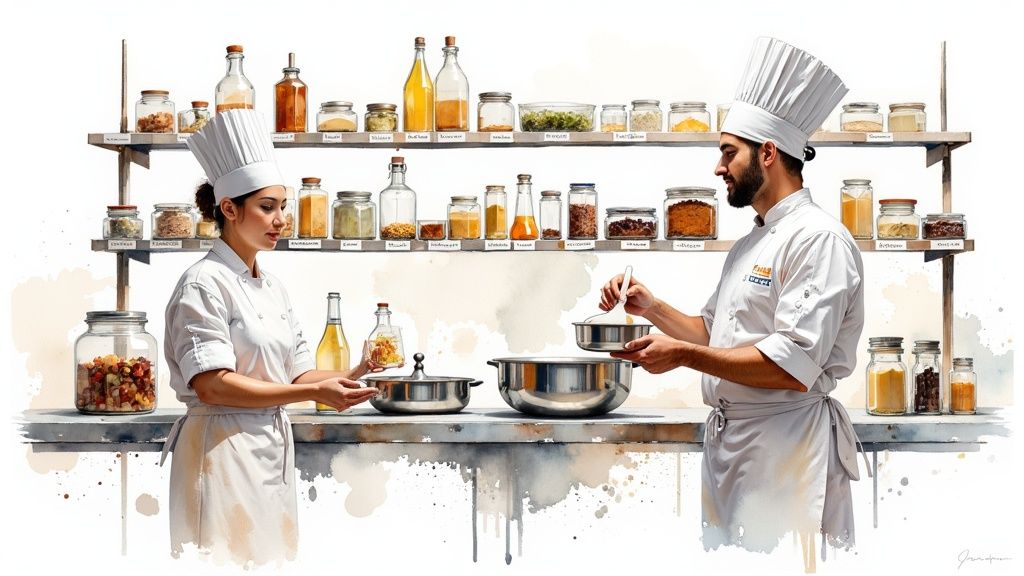Your Restaurant Isn't Failing Because of the Food
Learn how to improve restaurant operations with proven strategies. Boost efficiency, reduce costs, and elevate your dining business today!
Posted by
You’re staring at the P&L, wondering where the hell the money went. You blame the economy, rising food costs, the landlord—anyone but yourself.
Here's a truth nobody in this industry wants to admit: your restaurant isn't failing because of the food. It’s failing because your operation is a leaky bucket, and you’re too busy admiring your "culinary vision" to plug the holes. That “organized chaos” you’re so proud of? It’s just chaos. And it's bleeding you dry, one botched order and one wasted case of tomatoes at a time.
You're running a manufacturing and logistics company that happens to sell food. Start acting like it.
Your Gut is a Terrible CEO
Let's be blunt. "Going with your gut" is founder-speak for "I'm too lazy to look at the numbers."
Your gut didn't tell you the Tuesday special has a 70% food cost. It didn't tell you your star server voids more tickets than a rookie, probably because he's giving free drinks to his friends. The data will. Ignore it, and you’ll be lucky to survive the quarter.
About 60% of new restaurants make it through their first year, but that number plummets to roughly 20% after five years. They don't die from bad recipes. They die from a thousand tiny operational cuts. If you enjoy pain and want to see how bad it can get, you can find in-depth industry data on rezku.com.
The Profit Drains Are Staring You in the Face
Stop looking for complex problems. Your business is bleeding from obvious, boring wounds.
- Staff Inefficiency: An untrained team isn't just "bad service." They're a walking, talking liability actively lighting your money on fire.
- Inventory Guesswork: Your walk-in isn't a pantry; it's a vault full of cash that can rot. Treating it like an afterthought is financial malpractice.
- Customer Experience Lottery: If a guest’s experience depends on which cook is on the line that night, you don't have a brand. You have a coin flip.
This chart isn't academic nonsense. It's a picture of your bank account.

Slow service and inaccurate orders aren't "kitchen problems." They are customer problems that kill your reputation. Stop treating them like internal issues. Get your head out of the sand and build a business performance metrics dashboard that tells you the truth, even if it hurts.
Are You a Pro or an Amateur?
Your daily habits reveal your fate. Look at this list and be honest about which column you live in.
| Common (Failing) Practice | The Fix (Profitable Reality) |
|---|---|
| "We just eyeball the portions." | Strict, documented portion controls. No exceptions. |
| Schedules based on who's available. | Schedules based on sales forecasts. Data, not drama. |
| Vague, verbal-only staff training. | A documented, repeatable training system. The McDonald's model works. |
| Guessing what to order from suppliers. | Inventory managed with a brutal "first-in, first-out" (FIFO) system. |
| Inconsistent dish quality between chefs. | Standardized recipes that a trained monkey could follow. |
If you see yourself in the left column, congratulations—you’ve identified the source of the bleeding. Now, let’s talk about how to stop it.
Takeaway: Stop blaming external factors; your profit is being lost inside your own four walls.
Ditch the Vanity Metrics. Track What Hurts.
Your Instagram likes don't pay the rent. That glowing review from your aunt doesn't cover payroll. These are vanity metrics—digital pats on the back that make you feel good while your business slowly starves.
It's time to track the numbers that have consequences. The numbers that keep you up at night. Because what you don't measure, you can't fix. And trust me, something is always broken. We wrote a whole guide on what is data-driven decision-making if you're ready to stop flying blind.

The Only Three Numbers You Need to Obsess Over
Forget the 50-column spreadsheet. If you’re just starting, focus on the holy trinity of restaurant survival. Get these right, and you've earned the right to look at anything else.
- Cost of Goods Sold (COGS): The raw cost of ingredients. If this number is creeping above 35%, you're either being robbed, your portions are a joke, or your cooks are wasteful. It’s a direct measure of your kitchen’s discipline.
- Labor Cost Percentage: Your team's cost as a percentage of revenue. If it’s higher than 35%, your schedule is a mess. You're paying people to stand around or you're getting crushed on overtime.
- Table Turn Time: How long a party camps out at a table. Slow turns are the silent killer of a busy service. Shaving three minutes off your average turn time is like adding two new tables to your dining room.
These three metrics are your restaurant's heartbeat. If any of them are out of whack, the patient is sick.
Build a "Can't Ignore It" Dashboard
You don't need a data scientist. You need a single screen you can look at every morning that tells you if you won or lost yesterday. Your POS can do this. If it can't, get a new POS.
- Pull The Big Three: COGS, Labor, Turn Time. Front and center.
- Chart Sales vs. Labor: An hourly graph. The gaps and overlaps will scream at you. That's your money being wasted on overstaffing.
- Track Voids and Comps by Server: This is your "who's screwing up?" report. High voids mean training issues. High comps might mean theft.
Stop managing by wandering around and start managing by looking at the facts. You don't have a food cost problem; you have a data problem. You don't have a staffing problem; you have a data problem. The numbers will show you the wound so you can stop the bleeding.
Takeaway: Stop trusting your gut and start trusting the math; your POS is a truth machine if you bother to listen.
Stop Hiring People. Start Building a System.
That chaos on a Saturday night isn’t a “staffing problem.” It’s a leadership vacuum. When your team is fumbling, it’s because you haven’t given them a playbook. You expect them to be mind-readers, and then you get pissed when they guess wrong.
A restaurant is a stage. Every service is a live performance. If you haven't written the script, don't be surprised when your actors start improvising badly. Their failure is your failure. A well-trained team is a machine that prints money. Ignore them, and you’ll be lucky to survive the quarter.

Burn the Employee Manual. Create a Playbook.
Nobody reads your 50-page employee handbook. Nobody. It’s a legal document you shove in a drawer to cover your ass. Your team needs a playbook, not a novel.
Build checklists and diagrams so simple a new hire can run the play in five minutes.
- Host: A flowchart for greeting, seating, and managing the waitlist. Scripts for handling angry people. No more deer-in-the-headlights looks.
- Server: A laminated card in their apron with the service sequence. Greet in 60 seconds. Drinks in 3 minutes. Check back 2 minutes after food drop. Non-negotiable.
- Dish Pit: A diagram taped above the machine showing how to load it properly. Stop paying them to play Tetris badly.
Your restaurant doesn't rise to the level of your ambitions. It falls to the level of your systems. This is especially true when the average restaurant has 25 to 40 employees. Without systems, you're just paying for chaos. The data proves it; check the restaurant industry statistics if you don't believe me.
The 10-Minute Huddle is a Weapon. Use It.
Most pre-shift meetings are a joke. A manager mumbles about the 86-list and sends everyone off to fail. Stop it. Your huddle is the most important 10 minutes of the day. It’s a pre-game briefing, not a social club.
- The Win (1 Min): "Sarah, you upsold three bottles of the reserve cab last night. That's the standard." Public praise builds culture.
- The Intel (3 Min): "12-top from Google at 7:30. They're big tippers. Don't screw it up. We're 86ing the salmon after tonight, push the halibut."
- The Bottleneck (2 Min): "The POS lagged at 8 PM yesterday. Close checks immediately tonight. No excuses."
- The Mission (1 Min): "Tonight's mission is turn time. Be efficient, not pushy. Go."
Treat the huddle like you're going into battle, because you are.
Takeaway: Stop hoping for great service and start directing it with brutal, simple systems.
Your Walk-In is a Graveyard for Your Money
Let's be real. Your walk-in cooler is where profits go to die. Every box of wilting lettuce and slimy, forgotten steak is cash you might as well have set on fire. That little voice saying, "we’ll use it eventually," is the most expensive lie in the restaurant business.
Stop treating inventory like a chore. It's cash flow management. You wouldn't leave stacks of twenties out to mold, so stop doing it with your ingredients.
FIFO Isn't a Suggestion. It's a Religion.
First-In, First-Out. The oldest product goes first. Always. No exceptions.
If your line cooks are grabbing the new box because it's at the front, you're paying them to throw away the older, perfectly good product. This is a culture problem. Beat it into their heads until it's muscle memory. Label everything. Organize your shelves. A disorganized walk-in is a sign of a dying business. For practical ways to stop the bleeding, read these 3 Ways To Help Reduce Food Waste In A Restaurant.
Your Menu is Secretly Killing You
That dish with the imported Spanish octopus that you sell twice a week? It's not a signature item; it's a vanity project. Kill it. Your ego is not a valid reason to carry a low-margin, high-spoilage ingredient.
Your POS data doesn't lie. Run a report of your least popular items. Cross-reference it with their food cost. Anything that’s both unpopular and expensive gets cut. No funerals. The job of your menu is to make money, not to be a museum of your culinary experiments.
Par Levels: The Antidote to "Feelings"
Stop letting your chef order based on "a feeling." Amateurs guess. Professionals use par levels. This is the non-negotiable minimum and maximum amount of an item you should have in stock. It turns ordering into a simple math problem.
- Track your actual usage of an item for two weeks.
- Factor in delivery schedules and weekend rushes.
- Set a minimum (reorder point) and a maximum (don't buy more than this).
When inventory hits the minimum, you order up to the maximum. That's it. No emotion. No guesswork. You've just built a system to save you from your own bad instincts.
Takeaway: Treat your inventory like cash, your menu like a sales tool, and your ordering like a science.
Stop Buying Tech Toys. Start Buying Weapons.
Most restaurant tech is a solution looking for a problem. You don't need a VR menu. You need tools that attack your biggest, dumbest, most repetitive problems. Tools that either make you money or save you time, which is the same damn thing.
Founders get distracted by shiny objects. It's a trap. The right tech solves a real problem that affects your cash flow. The wrong tech is just an expensive hobby.
Your POS Is Your Brain. Stop Using a Dumb One.
Your Point of Sale system is the central nervous system of your business. If it's a clunky relic from 2005, you're operating with a traumatic brain injury.
A modern POS is your non-negotiable source of truth for:
- Sales Data: What's selling and who's selling it.
- Inventory Tracking: Automatically deducting ingredients as you sell them.
- Staff Performance: Who's voiding tickets and why.
- Customer Data: Who your regulars are.
If your POS can't do this, you don't have a tool—you have a boat anchor. Ditch it. A good cloud-based POS pays for itself in months. This is the foundation of a real business intelligence implementation.
Reclaim Your Customers from the Delivery Mafia
Those third-party delivery apps are parasites. They take a 20-30% cut and hold your customer data hostage. Stop whining about it and fight back. Build your own direct online ordering system.
Use the apps for what they are: customer acquisition channels. A marketing expense. Then, staple a flyer to every single delivery bag offering a 10% discount on their next order if they use your direct portal. Slowly, you steal their customers and make them your customers. You own the relationship. You own the data. You own the margin.
The Only AI That Matters Right Now
Forget the robot chef fantasies. The only AI worth a damn for restaurants right now is the one that does the boring work you hate. I’m talking about AI that reads all 500 of your online reviews and tells you exactly what's broken.
A review that just says "service was slow" is useless. But an AI that says, "27% of your negative reviews on Tuesdays mention 'slow service' and specifically reference waiting for the check between 8-9 PM"? Now you have a sniper target. You don't have a "service problem"; you have a payment processing bottleneck on Tuesday nights. You can fix that.
The industry is waking up; 96% of restaurants are investing in this kind of tech. Read the 2025 restaurant trends if you want to know what's coming.
Takeaway: Buy tech that solves a specific, expensive problem—otherwise, you’re just lighting cash on fire for fun.
Stop Admiring the Problem. Go Fix Something.

You've read this far. You know your operation is a mess. The gap between your current reality and a profitable restaurant isn't knowledge. It's execution. Reading more essential tips and strategies to improve restaurant operations won't help you. Doing something will.
Stop trying to boil the ocean. You'll get paralyzed and do nothing.
Pick One Fire. Put It Out.
What’s the single biggest thing keeping you up at night?
- Food costs making you want to vomit?
- Staff turnover that feels like a revolving door?
- Reviews that are tanking your reputation?
Pick one. Just one. Attack it with furious, relentless focus. Implement one system. Master it. Then move to the next fire. This isn't a project; it's a street fight.
Stop whining about thin margins and start building an operational machine that defends them with cold, hard systems.
Get in the trenches and fix your customer feedback loop by analyzing every single review with Backsy.
Frequently Asked Questions
No fluff. Just answers.
How can I improve restaurant operations with no money?
Stop making excuses. The best improvements are free. Enforcing FIFO costs $0. Running a 10-minute huddle that isn’t a waste of time costs $0. Creating simple checklists for opening and closing costs $0. The biggest leaks in your operation are almost always caused by a lack of discipline, not a lack of cash.
What's the biggest mistake owners make?
Ego. Thinking your brilliant food absolves you from the boring, unglamorous work of building systems. It doesn't. A Michelin-star dish delivered by a chaotic, untrained server to a dirty table is still a failure. You're not just an artist; you're a factory manager. Act like it.
Is my staff the problem?
Probably not. Your leadership is. A "bad employee" is a symptom of your bad systems, bad training, or a bad culture you've allowed to fester. Before you blame the server, look at the tools and the playbook you've given them. Fix your system before you fire your people.
How much does tech really matter?
Less than the sales reps claim, but more than your stubbornness will admit. Don't buy shiny toys. Buy weapons. A modern POS that gives you clean data is non-negotiable. A direct online ordering system is non-negotiable. Everything else is a distraction until you’ve mastered the basics. The goal isn't to be a "high-tech restaurant." The goal is to be a profitable one.
The global restaurant industry is projected to hit $4.03 trillion by 2025. Your competitors are getting smarter. Your customers are getting more demanding. Adapt or die. If you need more proof, explore more on these global restaurant industry statistics.
Stop guessing what your customers hate about your operations and let Backsy give you a brutally honest, AI-powered punch list of exactly what to fix.